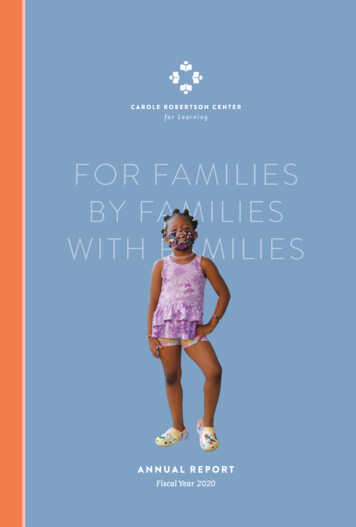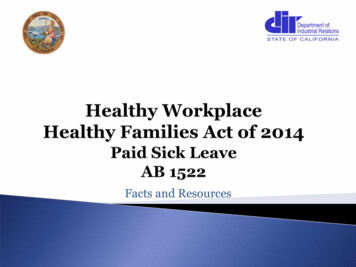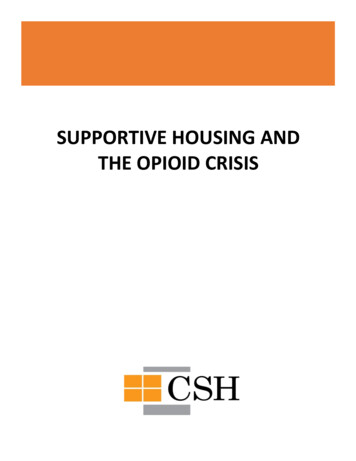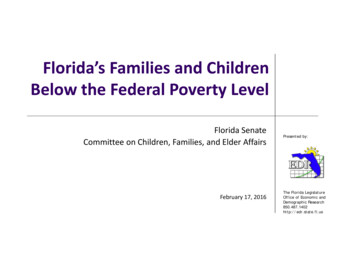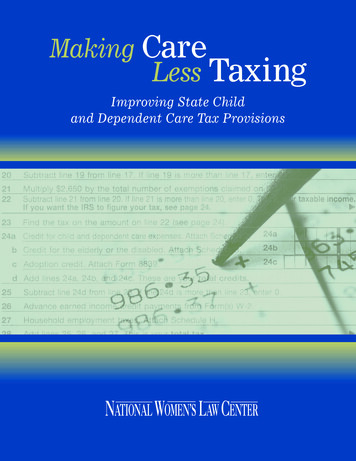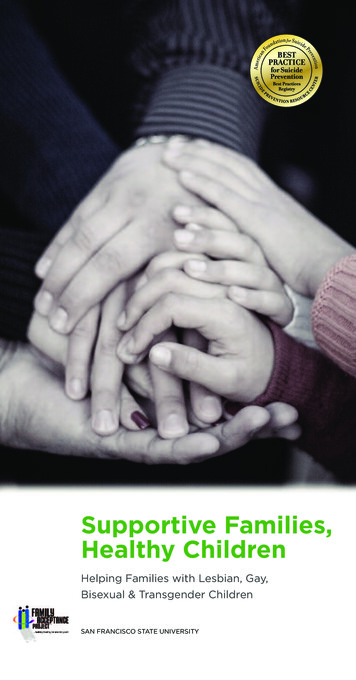
Transcription
Supportive Families,Healthy ChildrenHelping Families with Lesbian, Gay,Bisexual & Transgender ChildrenSAN FRANCISCO STATE UNIVERSITY
“You haveto start withthe family.Now we know how harmful it is for gay kidsnot to be accepted, not to be loved, and to bevictimized. The more we talk about it, and the morepeople embrace their gay children and form familieswhere they are accepted and loved—and notdiscriminated—they will thrive, the kids will thrive.”LEONORA, MOTHER OF A LESBIAN DAUGHTER,WITH 2 GRANDCHILDREN
Supportive Families,Healthy ChildrenHelping Families with Lesbian, Gay,Bisexual & Transgender ChildrenBYCaitlin Ryan, PhD, ACSWDirector, Family Acceptance ProjectTMSan Francisco State UniversityFUNDED BYThe California Endowment2009
Supporting Our WorkThe Family Acceptance ProjectTM is funded by foundations and individual donors.Contributions are tax-deductible. Donors can contribute by mail or online.For information on making a contribution, visit our webpage at:http://familyproject.sfsu.edu/donations, or send us an e-mail at: fap@sfsu.eduFAMILY ACCEPTANCE PROJECT RESEARCH TEAMCaitlin Ryan, PhDRafael Diaz, PhDJorge Sanchez, BATeresa BetancourtDave Huebner, PhDProject DirectorSenior Quantitative AnalystProject CoordinatorResearch AssociateSurvey Development TeamFAMILY INTERVENTION TEAMCaitlin Ryan, PhDLynn Dolce, MFTJorge Sanchez, BAKurt Schroeder, MBAProject DirectorClinical DirectorProject CoordinatorEvaluatorPRODUCTION CREDITSDesignMike Heffner, www.202design.comPhotographyCover photo, and photo, page17:Tracy Stephens, www.littlebeanonline.com;Inside front cover photo, and photo, page 11:Fotosearch.com;All other photos: iStockphoto.comThe Family Acceptance ProjectTM is developing a new family model to increase familysupport, decrease risk and promote the well-being of LGBT children and youth, based on ourresearch. We are developing a series of written and visual materials for families, caregivers andproviders. This booklet offers basic information to help parents and caregivers support theirLGBT children, to reduce their risk for depression, suicide, substance abuse and HIV infectionand to promote their well-being. It is available in English, Spanish and Chinese.For additional information, visit our webpage at http://familyproject.sfsu.edu or write to usat fap@sfsu.eduFUNDED BY THE CALIFORNIA ENDOWMENTWe are grateful to our funder and to the many LGBT adolescents, families and young adultswho shared their lives with us to help other families learn how to support their LGBT children.COPYRIGHT 2009 CAITLIN RYAN, PHDCitation:Ryan, C. Supportive families, healthy children: Helping families with lesbian, gay, bisexual &transgender children. San Francisco, CA: Family Acceptance Project, Marian WrightEdelman Institute, San Francisco State University, 2009.
IntroductionFamilies love their children and want the best for them.They want to protect their children and keep them from harm, and fromanyone who might hurt their child or adolescent.When parents hold their newborn infant, few of them think their childmight be gay or transgender. In fact, many parents dream of special timesin their child’s future, especially of their wedding and when theirchildren become parents themselves – with heterosexual partners.But many young people and adults are not heterosexual. Research showsthat between 2-7% of adults are lesbian, gay or bisexual (LGB). Studiesalso show that young people – both gay and heterosexual – first becomeaware of being sexually attracted toanother person at around age 10.As more information has becomeSupport Your Child’savailable about homosexuality, itLGBT Identity Even WhenYou Feel Uncomfortablehas been easier for many childrenand adolescents to realize that they“When we hold our baby in theare gay at younger ages.nursery for the first time, no oneIn our study of lesbian, gay,bisexual and transgender (LGBT)adolescents and families, we foundthat the average age that youthrealized they were gay was a littleover age 13. Many of them knewthey were gay at even younger ages– such as age 7 or 9. And some ofthem told their parents or otherfamily members.tells us that our baby might begay. By the time we know whoour children are, we may havehurt them in many ways.No one teaches us how to helpand protect our gay ortransgender children. We maythink we can help by trying tochange them – but we need tolove them for who they are.”—Erica, mother of a 14-year-oldtransgender youthBut many of them didn’t tellanyone because by then most had learned that being gay was shamefuland wrong from family, friends and other people in their community.They learned that gay people were called names, could be discriminatedagainst and hurt by others, and they could embarrass and shame theirfamilies. So from an early age, many gay children and adolescents learnhow to hide their deepest feelings from people they love.Introduction Supportive Families, Healthy Children 1
The parents and family members in our study – parents, grandparents,aunts and uncles, older brothers and sisters, guardians and foster parents— like you – told us that all parents and families should learn about ourstudy. They want other parents and caregivers to learn about our researchto help their gay and transgender children from early childhood – longbefore they realize that their child might be gay or transgender. Whatthose parents and family members realized – and what our research hasshown – is that families need to create a nurturing and supportiveenvironment long before they know who their children will become.What This BookletCan Tell YouThis booklet was written for families like yours to help strengthenfamilies and foster families with gay and transgender children andadolescents. And to help you provide support and to decrease your gayor transgender child’s risk for serious health and mental health problemsin adulthood. The information in this booklet comes from research wedid with families with LGBT adolescents and young adults.Talk with Your Child“Darnell came up to me and said,‘Mommy, I like boys.’ At firstI didn’t pay much attention.I wasn’t sure what he meant.A couple of weeks later, he saidit again: ‘I like boys. You know,like you like Daddy.’ I said‘Darnell, we’re going to readScripture.’ So I picked up theBible and read him a passage.I did that every time he tried totalk with me, and then I realizedthat his eyes were just lookingoff. He didn’t understand whatI was saying, but he knewI wasn’t listening. So then Iasked him to talk with me andtell me what he felt. I was reallyafraid of what he was saying,but he is my little boy. And Ilove him.”—Keisha, mother of a 7-year-old sonThis research is new and is juststarting to be published inmedical journals. This kind ofstudy has never been done before.So information on how familyacceptance and rejection affectsa gay child’s well-being has notbeen available before now.We studied LGBT adolescentsand their families who wereaccepting, unsure or conflictedand rejecting of their child’s gay ortransgender identity. Our researchidentified more than 100behaviors that families andcaregivers use to respond to theirchild’s gay or transgender identity.This includes behaviors such astelling your child he or she can’tcome to a family event becausethey are gay or lesbian, orwelcoming your child’s gay ortransgender friends to your home.2 Supportive Families, Healthy Children What This Booklet Can Tell You
Then we studied how each of these behaviors that families use toreact to their child’s gay or transgender identity affects the youngperson’s risk for health and mental health concerns. We studied howeach of these family behaviors affects a gay or transgender youngperson’s risk for depression, suicide, substance abuse, HIV and STDs.And we studied how these family behaviors affect their self-esteem,sense of the future, life satisfaction and social support.Now we can show families how to support gay and transgenderchildren. We can also tell parents and caregivers which behaviors canincrease your child’s risk for suicide, drug abuse and HIV. We canshow you how to increase your gay or transgender child’s self-esteem.This will help your child have a positive sense of the future andbecome a successful, happy and productive adult.We wrote this guide for families like yours to give you the basicinformation you need to help support your gay or transgenderchild.We will also develop more resources for families and providers.These will help decrease your gay or transgender child’s risk forhealth problems and help promote their well-being.What This Booklet Can Tell You Supportive Families, Healthy Children 3
What Our Research Shows:How Parents’ ReactionsAffect Their LGBT ChildrenOur research shows that families, parents, foster parents, caregiversand guardians can have a very dramatic impact on their LGBTchildren. We found that family acceptance promotes well-being andhelps protect LGBT young people against risk. And family rejectionhas a serious impact on a gay or transgender young person’s risk forhealth and mental health problems.Family RejectionMany parents believe that the best way to help their gay or transgenderchildren thrive as adults is to help them try to fit in with their heterosexualpeers. This may mean trying to change their child’s sexual orientation orgender identity. It also often means preventing them from learning abouthomosexuality or from finding gay or transgender resources to help themdevelop a positive sense of the future as a gay or transgender adult.Because parents see these behaviors as loving or caring for their gaychildren, they are often surprised and shocked to learn that their gaychildren experience these behaviors as rejection or abuse. Young peoplefeel that by rejecting their gay or transgender identity – a very core partof who they are as a person – their parents are rejecting all of who theyare. Instead, these very different ideas about how best to help their gaychildren lead to family conflict and increase the adolescent’s distress andloss of hope. Parents think they are helping their children survive in aworld they feel will never accept them by trying to prevent them fromlearning about or from being gay. But adolescents feel as if their parentsdon’t love them, are ashamed of them or even hate them.Many gay and transgender youth feel like they have to hide who they areto avoid being rejected, thrown out of their home, or hurting theirparents and other family members – who believe that homosexuality iswrong and even sinful. But hiding has a cost. It undermines a gay ortransgender adolescent’s self-esteem and sense of self-worth.Being valued by their parents and family helps children learn to valueand care about themselves. But hearing that they are bad or sinful sends adeep message that they are not a good person. This affects their ability to4 Supportive Families, Healthy Children What Our Research Shows
love themselves and care for themselves. And it increases risky behaviors,including risk for HIV, substance abuse and other negative behaviors. Italso affects their ability to plan for the future. Youth who are rejected maydo poorly in school. And they are much less likely to want to have afamily or to be parents themselves.Family Rejection AffectsHealth & Mental HealthOur research shows that gay and transgender youth who were rejected bytheir families because of their identity had much lower self-esteem. Theyhad fewer people they could turn to for help. And they were moreisolated than youth who were accepted by their families.Gay and transgender teens who were highly rejected by their parents andcaregivers were at very high risk for health and mental health problemswhen they become young adults (ages 21-25). Highly rejected youngpeople were:n More than 8 times as likely to have attempted suiciden Nearly 6 times as likely to report high levels of depressionn More than 3 times as likely to use illegal drugs, andn More than 3 times as likely to be at high risk for HIV and sexuallytransmitted diseasescompared with gay and transgender young adults who were not at all oronly rejected a little by their parents and caregivers – because of their gayor transgender identity.Family Rejection Affects Health & Mental Health Supportive Families, Healthy Children 5
Lifetime Suicide Attempts for HighlyRejected LGBT Young People(One or more vel of Family RejectionRyan, Family Acceptance Project, 2009This drawing shows the serious impact of high levels of family rejection on gay ortransgender young adults whose parents tried to change who they were. Theirparents or caregivers tried to prevent them from being gay or transgender. Orthey showed their disappointment or shame in having a gay or transgender childin other ways. (See page 8 for a list of rejecting behaviors that are very harmfulfor LGBT youth.)In this drawing, you can see that gay and transgender adolescents who had manyexperiences of rejection were at much higher risk for trying to commit suicide thanin families that were only a little rejecting or not at all rejecting (low rejection).Gay and transgender youth from highly rejecting families were more than 8times as likely to try to take their own lives by the time they were young adults. Infamilies that were moderately rejecting (had some negative reactions to their gayor transgender child – but also had some positive reactions) those young peoplewere only about twice as likely to try to kill themselves.Gay and transgender young adults who were highly rejected by theirparents and caregivers had poorer health than other gay or transgenderyoung people who were not rejected by their families. They had moreproblems with drug use. They felt more hopeless. And they were muchless likely to protect themselves from HIV or sexually transmitteddiseases. This puts them at higher risk for getting HIV and AIDS.For parents and caregivers, a little change – being a little less rejectingand a little more accepting – can make an important difference inreducing a young person’s risk for serious health problems, includingsuicide and HIV.6 Supportive Families, Healthy Children Family Rejection Affects Health & Mental Health
As with risk for suicide, gay and transgender young people with highlevels of family rejection were more than 3 times as likely to use illegaldrugs compared with young people from families with little or norejection. Their use of illegal drugs is cut in half when families aremoderately rejecting.Illegal Drug UseLOWrejectionMODERATErejectionHIGHrejectionLevel of Family RejectionRyan, Family Acceptance Project, 2009LGBT young people from highly rejecting families are more than 3 timesas likely to be at high risk for HIV and for sexually transmitted diseasesthan young people from families that were not rejecting. Their risk is cutin half when families are moderately rejecting.Risk for HIV nLevel of Family RejectionRyan, Family Acceptance Project, 2009Family Rejection Affects Health & Mental Health Supportive Families, Healthy Children 7
Family Responses to Learning How TheirBehavior Affects Their Child’s RiskWe found that families from all ethnic groups were shocked to learn thatreactions they thought would help or would protect their children frombeing gay or transgender – instead put their children at very high risk forhealth and mental health problems.These behaviors – such as trying to change their children’s identity or tryingto keep them away from gay friends to protect them – instead, isolated theirchildren and made them feel alone and unwanted. Many youth who arerejected actually feel like their parents and family members hate them.Parents may react with anger, fear, sadness or disgust when they learn thattheir child is gay or transgender. Some parents or family members may calltheir children names or get intophysical fights with them. OthersSome Family Behaviorsmay prevent their children fromthat Increase Your LGBTattending support groups for gayChild’s Risk for Health &and transgender youth, or fromMental Health Problemslearning about their gay orBehaviors to Avoidtransgender identity. Or parents andn Hitting, slapping or physicallyfoster parents may prevent themhurting your child because of theirfrom attending family eventsLGBT identitybecause how the gay or transgendern Verbal harassment or name-callingyouth looks or behaves is shamefulbecause of your child’s LGBTandembarrassing to them.identitynExcluding LGBT youth from familyand family activitiesnBlocking access to LGBT friends,events & resourcesnBlaming your child when they arediscriminated against because oftheir LGBT identitynPressuring your child tobe more (or less) masculineor femininenTelling your child that Godwill punish them becausethey are gaynTelling your child that you areashamed of them or that how theylook or act will shame the familynMaking your child keep their LGBTidentity a secret in the family andnot letting them talk about it Caitlin Ryan, Family Acceptance Project, 2009Our research identified manybehaviors that parents andcaregivers use to reject their child’sgay or transgender identity. Wefound that some of these rejectingbehaviors – such as blockingaccess to gay friends and resourcesor preventing a gay youth fromattending family events – were justas harmful as physically beatinga gay or transgender child.Instead, these behaviors thatparents and caregivers may useto try to protect their childrenfrom harm put them at very highrisk for suicide, depression andother health problems.A list of harmful behaviors thatincrease your gay or transgender8 Supportive Families, Healthy Children Family Responses
child’s risk for health and mentalhealth problems in adulthoodis included in the box on page 8.These behaviors should alwaysbe avoided.Some Family Behaviors thatReduce Your LGBT Child’s Riskfor Health & Mental HealthProblems & Help PromoteTheir Well-BeingBehaviors that HelpUncertaintyand ConcernMany parents feel conflicted whenthey learn that their child is gay.They are unsure how to react.They may feel disappointed,concerned and don’t know how tohelp their gay or transgender child.They may respond cautiouslysince they don’t want to encouragetheir child’s gay or transgenderidentity, but they also don’t wantto push their child away.Parents often fear that others maytry to hurt their gay or transgenderchildren. And fear motivates manyparents to react negatively to theirchildren’s LGBT identity – to try toprotect their children. Fearmotivates many parents, fosterparents and caregivers to try todiscourage or change their child’sgay or transgender identity.nTalk with your child or foster childabout their LGBT identitynExpress affection when your childtells you or when you learn thatyour child is gay or transgendernSupport your child’s LGBTidentity even though you mayfeel uncomfortablenAdvocate for your childwhen he or she is mistreatedbecause of their LGBT identitynRequire that other family membersrespect your LGBT childnBring your child to LGBTorganizations or eventsnTalk with clergy and help yourfaith community to supportLGBT peoplenConnect your child with anLGBT adult role model to showthem options for the futurenWelcome your child’s LGBTfriends & partners to your homenSupport your child’sgender expressionnBelieve your child can have ahappy future as an LGBT adultThe most important way that 2009, Caitlin Ryan, PhD, Family Acceptance Projectparents, families and fosterfamilies can help their gay ortransgender children is to support that child. This helps their LGBT childdevelop a deep sense of self-worth and self-esteem. For many families,this may not seem possible – at first. But building a child’s inner strengthby helping them learn to value themselves can help your gay ortransgender child deal with discrimination and rejection from others.How you react to your gay or transgender children has a deep and lastingimpact on their lives. It affects your relationship with your child andyour family. And our research shows that your reactions affect yourchild’s health and well-being.Our research has identified many ways to express support that can helpyour gay or transgender child and show them that you love them, even ifUncertainty and Concern Supportive Families, Healthy Children 9
you disagree with their being gay or transgender. We tell parents andcaregivers to be honest about their feelings, because children know howtheir parents really feel. If you are conflicted about having a gay ortransgender child, be honest with your child about your feelings andconcerns. And be sure to tell your child that you love them.Knowing that you love your child will reassure them that you won’treject them, and though you may feel disappointed or upset, you will notthrow them out of the home or abandon them. This will also help youcreate the space to communicate and to talk with your child about thingsthat are difficult or shameful. Talking with your child and sharing yourfeelings and experiences will help you and your child – and your family– stay connected with each other and grow together as a family.Family Acceptance Helps ProtectAgainst Risky BehaviorsIn our study, we spoke with many parents and caregivers who openlyaccepted their gay or transgender children. From the very beginning,when they first learned that their children were gay or transgender, theseparents and foster parents reacted with affection. They told their childrenthey loved them, and showed their care in many other ways. Forexample, they expressed support by advocating for their LGBT childrenwhen they were discriminatedagainst, or by welcoming theirConnect Your Child withchild’s gay or transgender friendsLGBT Resourcesinto their home. Or they asked“We found out our son was gaytheir child to talk about being gaywhen he was in middle school. Ior transgender in a way that feltreached out to get as muchsupportive to their child.information as I could. We tookhim to gay events so he couldsee other gay people leadingregular lives.Later, we met older Asian gaymen in their 50s and 60s whospoke with great pain abouthaving to live a lie, and neverbeing able to be honest aboutwho they were with theirparents. One finally told hismother he was gay and she said.‘This is the worst day of my life.’My wife and I support our son110%. And this means that wehave to speak out and tell otherparents that we need to beproud of our gay kids.”—John, father of 15-year-old gay sonA list of supportive behaviors thatdecrease your LGBT child’s riskfor health and mental healthproblems in adulthood andpromote their well-being isincluded in the box on page 9.We found that young adults whoseparents and foster parentssupported their gay or transgenderidentity had better overall health,and mental health. They hadhigher self-esteem and were muchless likely to be depressed, to useillegal drugs, or to think about ortry to kill themselves.10 Supportive Families, Healthy Children Family Acceptance
“We tell parents and caregiversto be honest about their feelings, becausechildren know how their parents really feel.And be sure to tell yourchild that you love them.”Family Acceptance Supportive Families, Healthy Children 11
We also found that when gay and transgender youth were accepted bytheir families, they were much more likely to believe they would have agood life and would be a happy, productive adult. In families that werenot at all accepting of their adolescent’s gay or transgender identity, onlyabout 1 in 3 young people thought they would have a good life as a gayadult. But in families that were extremely accepting, almost all LGBTyoung people thought they would have a good life.Youth Believe They Can Be A Happy LGBT AdultLevel of 77%A LITTLEaccepting59%NOT AT ALLaccepting35%Ryan, Family Acceptance Project, 2009Gay and transgender young people who are accepted and not rejectedby their families are much more likely to want to have a familythemselves. They have much closer relationships with their families.And they are much more satisfied with their lives than LGBT peoplewho are not accepted by their families.Youth Want to Become a ParentLevel of 50%A LITTLEaccepting35%NOT AT ALLaccepting10%Ryan, Family Acceptance Project, 200912 Supportive Families, Healthy Children Family Acceptance
Helping Yourselfand Your LGBT ChildWe know that many families may find it very hard to think aboutaccepting a gay or transgender child because these issues make them feelvery uncomfortable or may go against their beliefs. So instead, thinkabout trying to support your child, trying to keep your family fromfracturing, and strengthening family bonds.We know you love your child and want the best for them. We knowyou would protect your child from anyone who might try to hurt them.Our research shows that specific behaviors – such as preventing yourchild from having a gay friend orfrom getting accurate informationabout their LGBT identity –Advocate for YourLGBT Childare harmful for them and putthem at high risk for suicide and“One day Jose came home fromother serious health problems.school with bruises all over hisAt the same time, we foundface and arms. I asked him whathappened and he didn’t want tothat behaviors such as findingtell me. But I found out thata positive role model for yoursome boys had beaten him upgay or transgender child orand threatened him. They calledtalking openly with themhim ugly names and he said heabout their LGBT identityhated school. But I could tell heare ways of supporting them.was afraid to go back there.Start by finding time to talk withthem. Ask your child to tell youabout their experiences and whatthey are feeling. Ask them howyou can support them and whatthey need from you to help them.Don’t interrupt – just listen.I said, ‘You go in tomorrow andtell your teacher what happened,and I’m going to talk to theprincipal’. I went in to theprincipal, Jose spoke to histeacher and I made sure theytook care of the situation rightthere. He’s not a fighter and Ineeded to show him how to standup for himself. I wouldn’t alwaysbe around to stand up for him.And I didn’t want him to be afraid.”Find a support group for yourself totalk with other parents and familymembers with gay and transgender—Jorge, foster parent ofa 12-year-old gay sonchildren and adolescents. Weinclude national resources at theback of this booklet and we haveleft space for you to write down other resources in your community.Learning about your child’s sexual orientation and gender identity willhelp you understand and help them. We have learned from manyfamilies about their journey to understand their gay and transgenderchildren. Information and education are always the first step.Helping Yourself and Your LGBT Child Supportive Families, Healthy Children 13
Resources from theFamily Acceptance ProjectWe have listed basic information in this booklet about some familyreactions that can hurt your gay or transgender child as well as othersthat can help your child. This information is based on our research withLGBT young people and their families. We are developing otherpublications and materials. And we are also developing a new familyapproach to help families increase support for their gay and transgenderchildren. We will share these resources on our webpage(http://familyproject.sfsu.edu) and with community and nationalorganizations. And we will share them with groups in other countries, aswe develop them.We encourage you to visit our webpage and to use our materials. Let usknow how we can improve them and make them more useful for you andyour family. Share our materials with your family physician and with yourchild’s health and mental health providers, school counselors and teachers.14 Supportive Families, Healthy Children Resources
Resources for FamiliesResources for families with LGBT family members are different for eachcommunity. Here are a few resources to help you get started to findinformation and support to help yourself and your LGBT child.Family Acceptance ProjectTMRequire Respect in theFamily for Your LGBT ChildThe Family Acceptance ProjectTMdevelops research-basededucational materials, assessmenttools and resources, and providesservices to help ethnically andreligiously diverse families supporttheir LGBT and gender variantchildren. FAP is developing a newfamily service model to helpfamilies decrease their LGBTchildren’s risk and promote theirwell-being that will bedisseminated to communitiesthroughout the U.S. and to groupsin other countries.“My brother was coming over fora holiday dinner with ourfamilies. Before he came, I toldhim, ‘You have always beenwelcome in our home. But if youcome, I don’t want you to speakbadly about gay people in frontof our daughter. She is the samewonderful niece that you alwaysloved before you found out shewas gay. And we want you torespect her.’—Ed, father of an 18-year-old lesbiandaughterhttp://familyproject.sfsu.eduGender Spectrum Education & TrainingGender Spectrum Education & Training provides information andsupport for parents and families and an annual conference for familieswith gender-variant and transgender children. They also provide trainingon gender identity and expression for schools and providers for helpinggender non-conforming and transgender children and youth.www.genderspectrum.orgPFLAGPFLAG (Parents, Families and Friendsof Lesbians & Gays) is a nationalorganization with state and localchapters that provide education,information, and support forparents and families withLGBT family members, andreferrals to LGBTcommunity resourcesand services.www.pflag.org(202) 467-8180Resources Supportive Families, Healthy Children 15
What Does LGBT Mean?Sexual OrientationSexual orientat
transgender children. San Francisco, CA: Family Acceptance Project, Marian Wright Edelman Institute, San Francisco State University, 2009. FAMILY ACCEPTANCE PROJECT RESEARCH TEAM Caitlin Ryan, PhD Project Director Rafael Diaz, PhD Senior Quantitative Analyst Jorge Sanchez, BA Project Coordinator Teresa Betancourt Research Associate


